全文HTML
--> --> -->自旋电子学利用了电子的电荷与自旋作为信息的载体, 与传统半导体材料相比, 具有更优越的性能. 当前电子材料兼容的途径就是通过引入高浓度的磁性离子使非磁性半导体出现磁性, 甚至铁磁化. 随着自旋电子学材料的发展, 用磁性过渡金属元素离子注入二元半导体, 发现了同时具有磁性和半导体特性的新型磁性材料, 这在自旋电子学的研究中引起了人们极大的兴趣, 也为自旋电子学的发展起到了重要推动作用. 已有相关的研究工作发现, 将少量的磁性元素掺入II-VI族[14,15], IV族或III-V族等半导体中[16-18], 掺入的磁性原子替代半导体晶胞中的阳离子或阴离子, 或者通过缺陷技术在所研究的体系中形成缺陷, 研究发现了许多新型自旋电子学材料[19,20], Ahmad和Amin[21]发现Mn掺杂下Ga1–xMnxP和Ga1–xMnxAs是磁性半金属材料. 黄保瑞等[22]研究 了Cr掺杂纤锌矿GaN的磁性和光学性质, 发现Cr掺杂后材料在红外光区吸收增强, 具有优异的磁光性能. Shirai [23]采用3d过渡金属元素掺杂III-V族半导体GaAs, 研究发现多种半金属材料. 经过调研发现, III-V族化合物半导体材料在光电子器件、光电集成、超高速微电子器件和超高频微波器件及电路上等方面有着广阔应用[24,25]. 近年来通过利用过渡金属元素掺杂III-V族二元半导体发现了很多新型半金属材料[26-30]. 而近来研究人员对于III-V族半导体材料GaSb的关注逐渐提高, Abe等[31]利用分子束外延的实验方法研究了Cr掺杂GaSb的材料性质, 发现它们具有室温以上的铁磁性质. Se?a等[32]利用密度泛函方法研究了Mn掺杂GaSb, 发现掺杂后的材料具有铁磁半金属性质. 所以我们选取过渡金属Cr替换半导体材料GaSb中的阳离子Ga, 利用第一性原理展开研究. GaSb是具有闪锌矿晶体结构的直接带隙半导体, 禁带宽度约为0.72 eV, 晶格常数为0.61 nm[33]. GaSb具有电子迁移率高、高频低阈值、光电转化率高等特点[34-36]. 同时这种材料的晶格常数与其他各种三元、四元的III-V族化合物半导体材料的晶格常数近似匹配, 可以大大减少由晶格失配导致的应力、缺陷等问题, 因此成为制备长波LED及光电探测器、光纤通信器件的重要衬底材料[37-40]. 对相关文献和已有同类型研究工作进展[41-44]进行了解后, 我们选用过渡金属Cr离子注入GaSb来尝试研究, 希望发现新的自旋电子学材料.
 图 1 闪锌矿结构GaSb (a)结构图; (b)能带图
图 1 闪锌矿结构GaSb (a)结构图; (b)能带图Figure1. (a) Zinc-blende structure and (b) band structure of GaSb.
本文主要利用第一性原理计算的方法[49]研究过渡金属Cr离子注入GaSb的电学、磁学和光学性质. 所有计算采用密度泛函理论的第一性原理计算软件包VASP(vienna ab initio simulation package)[50,51]. 在模拟计算中, 选择缀加投影平面波方法(projected augmented wave, PAW)[52]来描述电子与原子核之间的相互作用, 电子与电子之间的关联相互作用采用广义梯度近似(generalized gradient approximation, GGA)[53]中的PBE (Perdew Bueke Ernzerhof)[54]形式. 首先对各结构体系进行平面波截断能和布里渊区积分的Monkhorst-pack特殊K点选取进行优化. 经过测试, 平面波截断能取400 eV, K点网格大小选取7 × 7 × 7. 在晶体结构优化和原子弛豫过程中, 体系总能量收敛精度和单个原子上的力收敛精度分别为10–5 eV和10–4 eV/atom. 分别计算Ga1–xCrxSb (x = 0.25, 0.50, 0.75) 的无磁性、铁磁性和反铁磁性的总能量随晶格常数变化的关系. 因为PBE泛函计算会低估晶体带隙, 所以我们在计算电子能带时加入了杂化密度泛函Heyd-Scuseria-Ernzerhof (HSE06)[55,56]对电子能带计算进行修正, 使能带计算结果更加合理.
3.1.磁性质
计算了在不同浓度Cr离子注入下ZB Ga1–xCrxSb (x = 0.25, 0.50, 0.75)材料的电子基态性质[57]. 对于离子注入体系的铁磁态 (ferromagnetic, FM)、反铁磁态 (antiferro- magnetic, AFM)的计算, 主要是通过使偶数的Cr原子自旋呈现平行、反平行、交叉反平行来实现的, 我们在替换原子后的闪锌矿结构晶胞基础上扩为
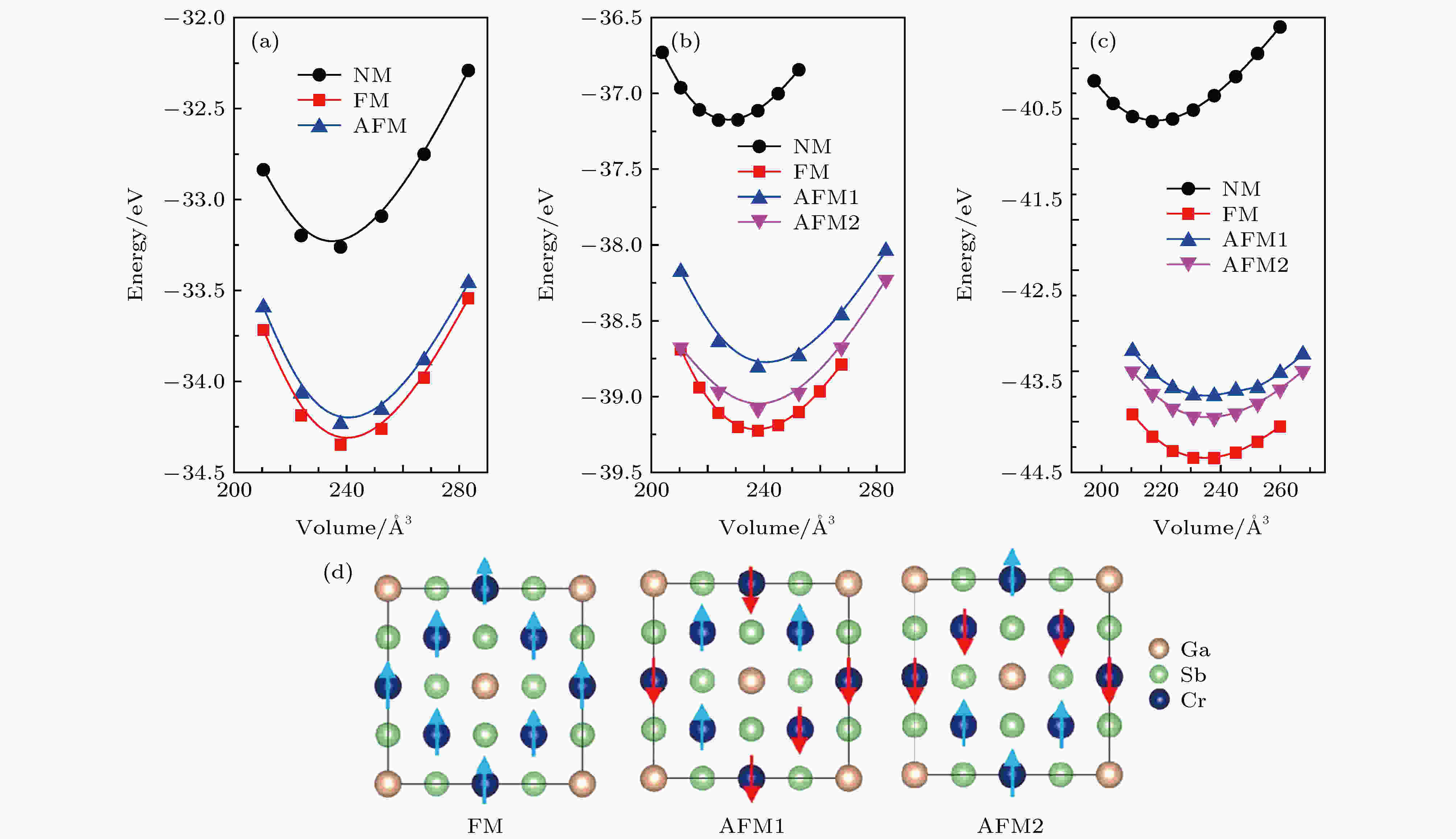 图 2 晶体Ga1–xCrxSb (x = 0.25, 0.50, 0.75)结构优化的能量-体积关系图 (a) Ga0.75Cr0.25Sb; (b) Ga0.5Cr0.5Sb; (c) Ga0.25Cr0.75Sb; (d) Ga0.25Cr0.75Sb的铁磁态及两种反铁磁性磁序分布
图 2 晶体Ga1–xCrxSb (x = 0.25, 0.50, 0.75)结构优化的能量-体积关系图 (a) Ga0.75Cr0.25Sb; (b) Ga0.5Cr0.5Sb; (c) Ga0.25Cr0.75Sb; (d) Ga0.25Cr0.75Sb的铁磁态及两种反铁磁性磁序分布Figure2. The energy-volume curve of Ga1–xCrxSb (x = 0.25, 0.50, 0.75): (a) Ga0.75Cr0.25Sb; (b) Ga0.5Cr0.5Sb; (c) Ga0.25Cr0.75Sb; (d) the FM is ferromagnetic state and AFM stands for two types of antiferromagnetic state for Ga0.25Cr0.75Sb.
在Ga1–xCrxSb (x = 0.25, 0.50, 0.75)计算中发现, 当处于平衡晶格常数时, 它们的总磁矩为玻尔磁子μB的整数倍, Ga1–xCrxSb (x = 0.25, 0.50, 0.75)的整数总磁矩分别为3.0μB, 6.0μB, 9.0μB, 这一特性符合铁磁半金属的性质. 如图3所示为这三种铁磁半金属材料的磁矩随晶格常数变化在 ± 20%的关系, 我们发现总磁矩主要由Cr原子上d轨道贡献, 额外的贡献来自于位于Cr其他轨道和邻近的Sb原子的p轨道, 且Cr和Sb贡献的磁矩方向相反. 在 –5%—20%的晶格变化范围内, Ga1–xCrxSb总磁矩仍然保持μB整数倍不变, 而Cr-d轨道的贡献磁矩随着晶格常数的增加而增大, 并在达到平衡晶格常数后, 增大趋势减缓[60].
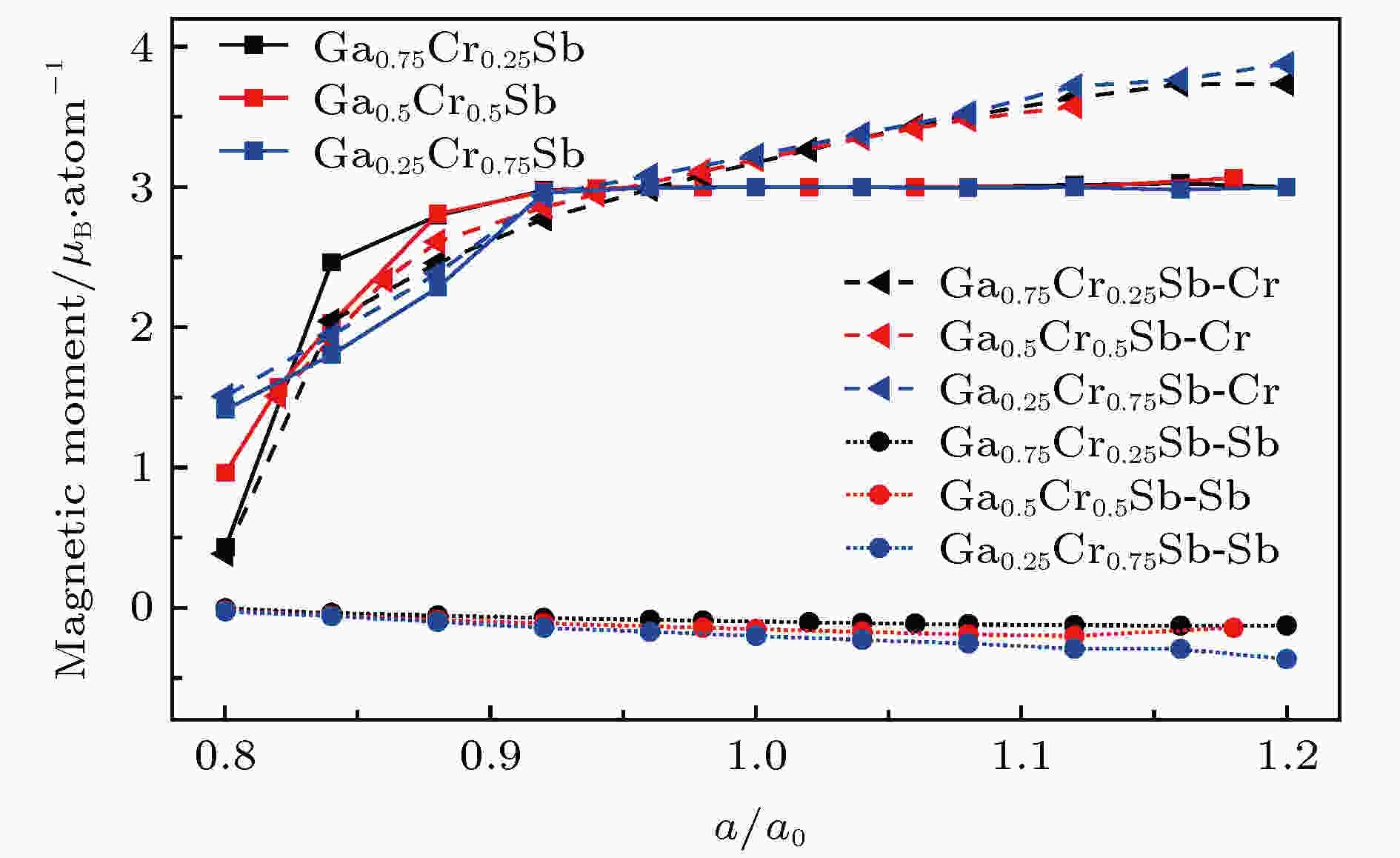 图 3 Ga1–xCrxSb单胞总磁矩及Cr-d轨道和Sb-p轨道贡献磁矩随晶格变化图 同一颜色的表示是同一浓度材料, 线上的方块、三角、圆形分别表示总磁矩、Cr原子d轨道贡献磁矩和Sb原子p轨道贡献磁矩
图 3 Ga1–xCrxSb单胞总磁矩及Cr-d轨道和Sb-p轨道贡献磁矩随晶格变化图 同一颜色的表示是同一浓度材料, 线上的方块、三角、圆形分别表示总磁矩、Cr原子d轨道贡献磁矩和Sb原子p轨道贡献磁矩Figure3. The total magnetic moment per formula and the contribution of magnetic moment from Cr-d and Sb-p orbits as a function of the relative change of lattice constant of Ga1–xCrxSb. The same color represents the same concentration. The square, triangle and circle on the line represent the total magnetic moment, the contribution magnetic moment of the Cr atom d-orbit, and the magnetic moment of the Sb atom p-orbit, respectively.
GaSb中的Ga被Cr取代时, 首先Ga空位在价带中产生三个空穴, 留下Sb悬挂键. 当Cr占据Ga位点时, 它会提供三个电子以实现Cr-Sb键合. 然后Cr留下3个未配对的d电子, 产生3μB的磁矩. Cr和近邻的Sb之间的磁耦合总是反铁磁性的, 如表1所示. 可能是由于局部Cr-d轨道与Sb-p轨道之间的p-d交换相互作用, 从而实现了Cr离子注入后GaSb由无磁材料到磁性材料的转变. 这些结果表明, GaSb半导体可以作为实现自旋电子器件的母体材料.
| Mtot/NCr/μB | MCr/μB | MSb/μB | 居里温度/K | 基态性质 | 材料性质 | |
| GaSb | 0 | — | — | — | NF | SM |
| Ga0.75Cr0.25Sb | 3.00 | 3.266 | –0.124 | 872 | FM | HMF |
| Ga0.5Cr0.5Sb | 3.00 | 3.113 | –0.143 | 1104 | FM | HMF |
| Ga0.25Cr0.75Sb | 3.00 | 3.224 | –0.176 | 1372 | FM | HMF |
| CrSb | 3.00 | 3.154 | –0.152 | 1600[61] | FM | HMF |
表1Ga1–xCrxSb (x = 0, 0.25, 0.50, 0.75, 1.00)总磁矩Mtot/NCr, Cr原子d轨道磁矩MCr, Sb原子p轨道磁矩MSb, 居里温度, 其中SM表示半导体, HMF表示半金属铁磁体
Table1.Ga1–xCrxSb (x = 0, 0.25, 0.50, 0.75, 1.00) magnetic moment Mtot/NCr, Cr atom d-orbit magnetic moment MCr, Sb atom p-orbit magnetic moment MSb, Curie temperature, SM and HMF represent semiconductor and half-metal ferromagnetic, respectively.
磁性材料的铁磁转变温度一直是关乎材料实际应用的一个重要问题, 而CrSb是已被研究证明的铁磁半金属材料, 我们采用与文献一致的平均场方法估算了三种铁磁半金属的居里温度[62-64],

2
3.2.电子性质
然后计算了平衡结构下Ga1–xCrxSb (x = 0.25, 0.50, 0.75, 1.00)的电子结构. 如图4所示, Ga1–xCrxSb具有相似的能带结构, 我们发现它们自旋向上的能带穿过费米能级EF, 呈金属性; 而自旋向下的能带在费米能级处都有一个带隙, 呈现半导体性, 符合半金属能带结构的特点. 由图4可以看出, 离子注入后的Ga1–xCrxSb的半导体性质能带导带底和价带顶都位于布里渊区Γ对称点, 属于直接带隙. 因为ZB结构的GaSb和CrSb晶体材料早已被研究, 我们还是采用本研究的方法计算了未离子注入的ZB GaSb, 得出GaSb具有直接带隙半导体性质[46], 及完全将Ga原子替换为Cr的ZB CrSb的电子结构, 和CrSb呈铁磁半金属性[65], CrSb能带图如图4(d)所示, 我们的结果与文献中的材料电子结构等性质一致(Ga1–xCrxSb (x = 0, 0.25, 0.50, 0.75, 1.00) 计算的平衡晶格常数和基态性质及相关文献值见表2). 通过对比发现, 离子注入Cr后GaSb出现铁磁半金属性质, 由此推测该系列半金属性是由离子注入的Cr原子所引起的.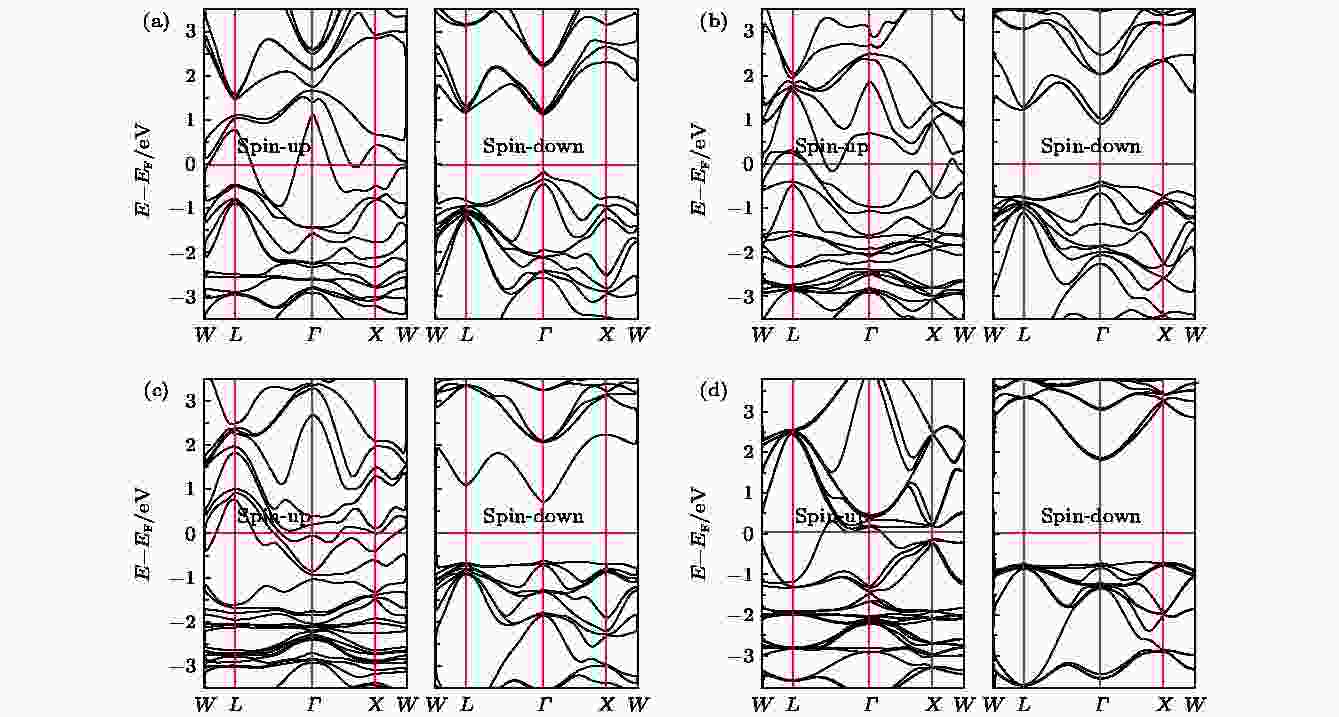 图 4 自旋能带结构图 (a) Ga0.75Cr0.25Sb; (b) Ga0.5Cr0.5Sb; (c) Ga0.75Cr0.25Sb; (d) CrSb
图 4 自旋能带结构图 (a) Ga0.75Cr0.25Sb; (b) Ga0.5Cr0.5Sb; (c) Ga0.75Cr0.25Sb; (d) CrSbFigure4. The spin-dependent band structure: (a) Ga0.75Cr0.25Sb; (b) Ga0.5Cr0.5Sb; (c) Ga0.25Cr0.75Sb; (d) CrSb.
| a0/? | LCS/? | LGS/? | HMHSE | HMPBE | SMHSE | SMPBE | |
| GaSb | 6.095 | — | 2.638 | — | — | 0.526 | 0.083 |
| 0.720[66] | 0.110[66] | ||||||
| Ga0.75Cr0.25Sb | 6.210 | 2.652 | 2.702 | 0.137 | 0.121 | 1.275 | 0.637 |
| Ga0.5Cr0.5Sb | 6.181 | 2.653 | 2.713 | 0.403 | — | 1.281 | 0.653 |
| Ga0.25Cr0.75Sb | 6.159 | 2.654 | 2.725 | 0.613 | — | 1.305 | 0.664 |
| CrSb | 6.128 | 2.654 | — | 0.657 | 0.750 | 2.327 | 1.52 |
| 0.774[65] | 1.646[65] | ||||||
| 0.751[67] | 1.650[67] |
表2Ga1–xCrxSb (x = 0, 0.25, 0.50, 0.75, 1.00)系列晶体各项性质, a0表示平衡晶格常数, LCS表示Cr—Sb键长, LGS表示Ga—Sb键长, HMHSE表示用HSE方法得到的半金属能隙(eV), HMPBE表示用PBE方法得到的半金属能隙(eV), SMHSE表示用HSE方法得到的半导体能隙(eV), SMPBE表示用PBE方法得到的半导体能隙(eV)
Table2.Crystals Properties of Ga1–xCrxSb (x = 0, 0.25, 0.50, 0.75, 1.00), the equilibrium lattice constant a0, Cr—Sb bond length LCS, Ga—Sb bond length LGS, the half-metal gap (eV) calculated by HSE HMHSE, denotes the half-metal gap (eV) calculated by PBE HMPBE, the semiconductor gap (eV) calculated by HSE SMHSE, and the semiconductor gap (eV) calculated by PBE SMPBE.
计算得出半导体GaSb处于平衡晶格常数时Ga—Sb的键长为2.638 ?, 对比该系列铁磁半导体材料中各原子之间的键长, 如表2中所列, 可以看出, 离子注入过渡金属Cr后, 由于电负性差异和各原子间电子轨道杂化, Ga1–xCrxSb中Cr的最外层轨道电子在键合中被消耗. 因为在元素周期表中Cr的离子半径(0.615 ?)和电负性(1.66)小于Ga的离子半径(0.620 ?)和电负性(1.88). 所以Cr—Sb的离子键键强大于Ga—Sb的离子键强, 而长度小于后者. 当GaSb中Cr的离子注入浓度增加时, 晶胞体积变小, 同时由于Sb离子的位置更加偏向Cr离子, 所以相应的Ga—Sb键长变长了, 而Cr—Sb键长随浓度变化不大. 由表2可以看出, HMF Ga1–xCrxSb (x = 0.25, 0.50, 0.75, 1.00)的半导体带隙和半金属能隙都随浓度增大而增大. 半金属材料的半金属能隙(half- metal gap HM gap)是在存在带隙的自旋子能带中, 费米能距离价带顶或导带底这二者中间最小值[68].
为了进一步研究该系列HMF材料出现半金属性质的原理, 因为Ga1–xCrxSb (x = 0.25, 0.50, 0.75)电子态密度比较相似, 所以选取Ga0.75Cr0.25Sb总态密度(total density of states, TDOS)和各原子分波态密度 (partial density of states, PDOS)为例进行分析, 为了更清晰地比较分析, 图5(a)和图5(b)分别为GaSb和Ga0.75Cr0.25Sb的电子态. 从图5(a)可以看出GaSb电子态无自旋极化, 所以GaSb没有磁性. 而Ga0.75Cr0.25Sb在费米面附近上自旋的态密度呈金属性, 而下自旋态有一明显带隙呈现半导体性, 所以Ga0.75Cr0.25Sb表现出磁性. 由于在Ga0.75Cr0.25Sb的费米能级处只存在一种自旋取向的电子, 由自旋极化率的定义
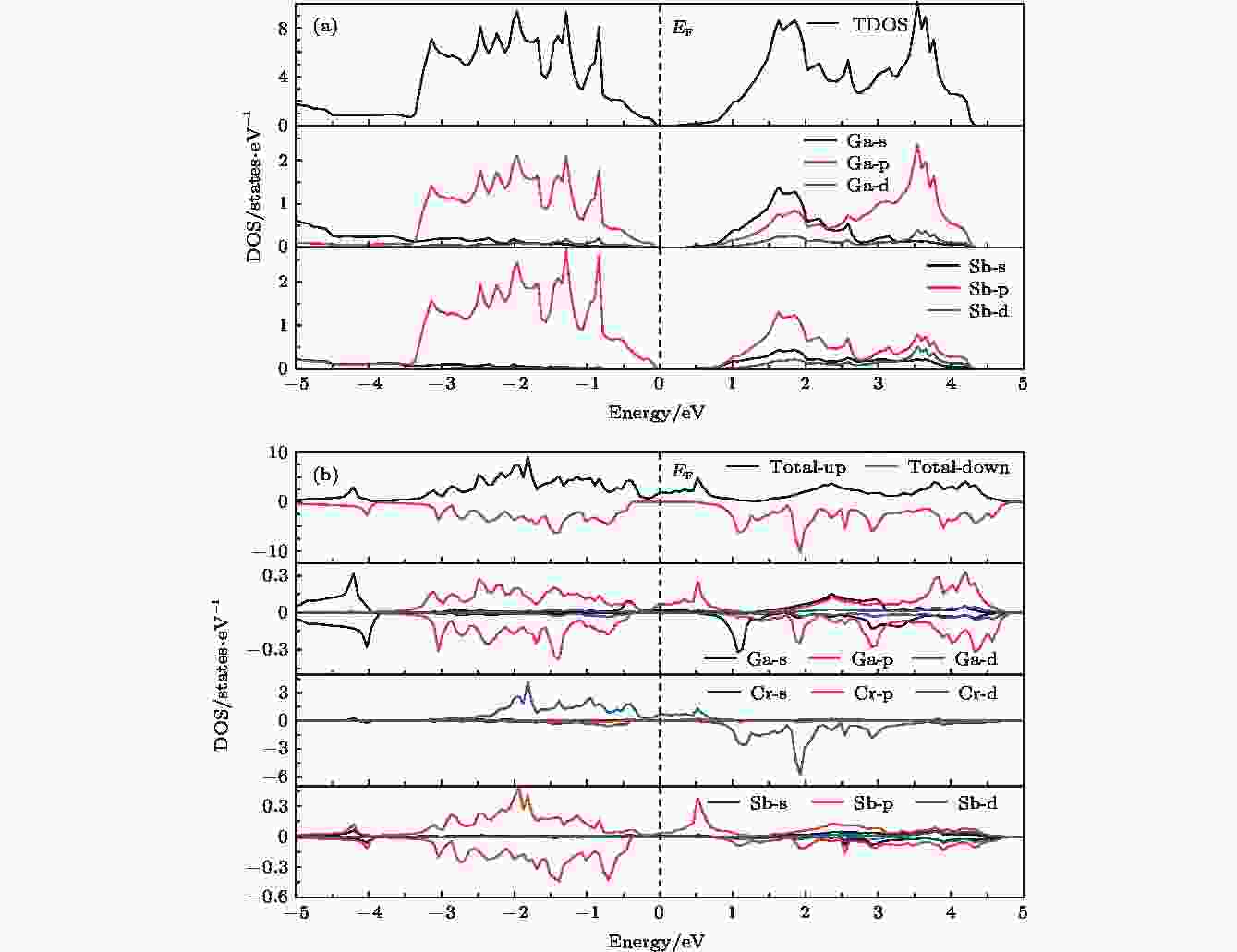 图 5 晶体电子态密度图 (a) GaSb; (b) Ga0.75Cr0.25Sb
图 5 晶体电子态密度图 (a) GaSb; (b) Ga0.75Cr0.25SbFigure5. Total electron density states of (a) GaSb; (b) Ga0.75Cr0.25Sb.


因为大多数材料的电磁性质、光学性质等都是来自原子之间p-d, d-d和s-p-d电子轨道杂化, 我们认为这与各原子电子组态以及各原子间电子轨道杂化有关[69-72]. 由于Cr的价电子组态分别为3d54s1, Ga的价电子组态为4s24p1, 最外层4p轨道只有1个电子, 而Sb的价电子组态为5s25p3, 它的5p态有3个电子, 是半填满态(p态的满壳层为6电子). 并且对比晶体中各个原子间的键长及态密度图, 我们认为在费米能级附近发生了强烈的杂化作用. 如表2中所示, 过渡金属原子Cr-Sb原子间距要小于Cr-Ga间距离, 也就表明电子杂化主要发生在过渡金属原子Cr与Sb原子之间.
从各原子分波态密度可以看出, Ga0.75Cr0.25Sb总电子态密度主要由Cr-d轨道电子贡献, 而Ga-p, Sb-p等其他电子轨道贡献较少. 从图5(b)中可以看出, TDOS和Cr-d的PDOS在–3—–0.5 eV的上自旋态和0.5—3 eV的下自旋态有相似的态密度分布. 并且Sb-p和Cr-d对应的PDOS在–3— –0.5 eV能量区段中具有类似的DOS形状. 这一现象揭示了Cr原子与其4个相邻的Sb原子之间的轨道杂化, 由于Cr原子取代相同位置处的Ga原子, 所以Cr将磁化转移到相邻的Sb原子上. 所以导带底部主要由Cr-d电子态占据, 价带部分是由Sb-p, Ga-p, Cr-d的电子占据, 因为Cr-d轨道和Sb-p轨道之间有较大的电子轨道杂化, Cr-d相互杂化作用随浓度增大也增加. 下自旋态中Sb的p态被Cr的d态推向较低的能量, 因此, 价带变为与Cr磁矩反平行的自旋极化. 此外, 由于下自旋态的费米能级没有电子态, 得到Ga1–xCrxSb是一个具有整数磁矩的半金属铁磁体. 这两种效应都增大了Cr-d电子的跃迁, 使得Cr-d带宽变大, 自旋向下带隙随着Cr浓度的增加呈增大趋势. Cr的3d轨道和Sb的5p轨道发生p-d电子杂化, Cr的3d电子态密度分布发生转移, 即电子轨道杂化使得晶体材料总的电子态密度重新分布, 这是Ga1–xCrxSb (x = 0.25, 0.50, 0.75)表现出铁磁半金属性的主要原因.
2
3.3.光学性质
固体的光学性质可以用介电函数








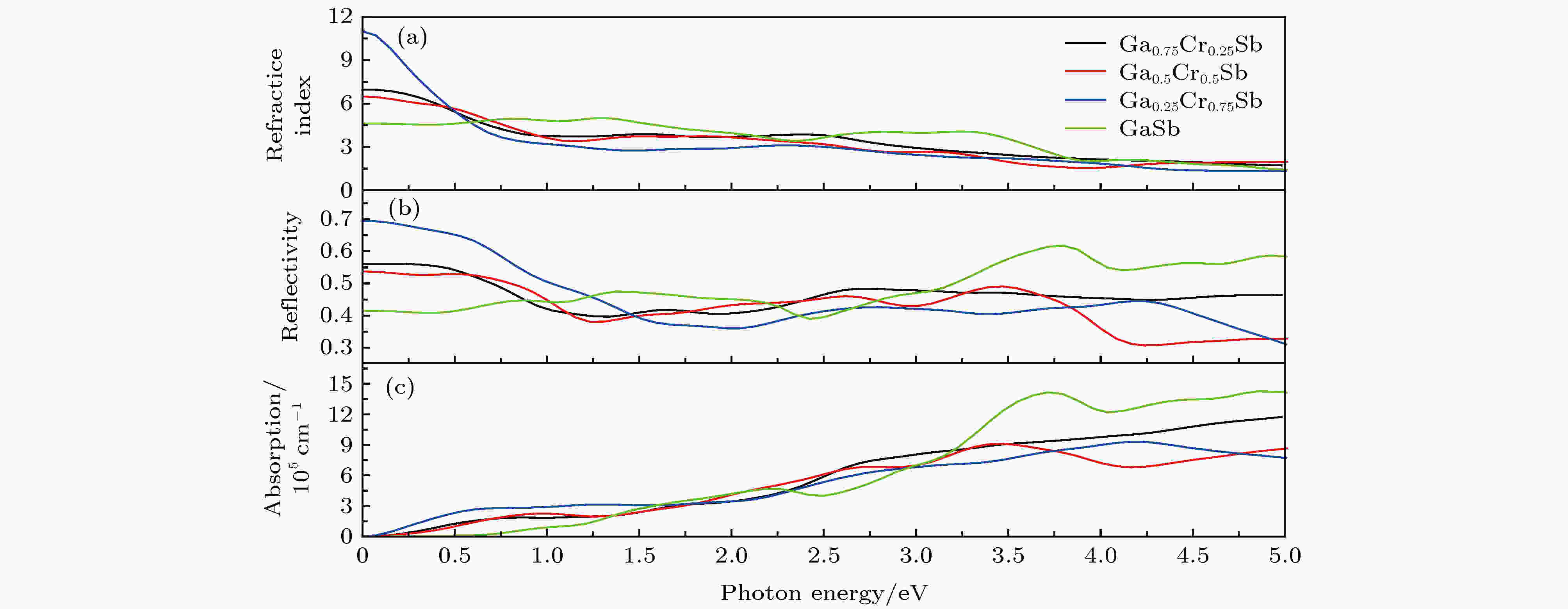 图 6 Ga1–xCrxSb (x = 0, 0.25, 0.50, 0.75)的光学性质图谱对比 (a)折射系数; (b)反射率; (c)吸收系数
图 6 Ga1–xCrxSb (x = 0, 0.25, 0.50, 0.75)的光学性质图谱对比 (a)折射系数; (b)反射率; (c)吸收系数Figure6. Comparison of optical properties of Ga1–xCrxSb (x = 0, 0.25, 0.50, 0.75): (a) The calculated optical refractive index; (b) the calculated optical reflectivity; (c) the calculated optical absorption coefficient.
由图6(c)可知, 在0—5 eV能量范围内, GaSb及Ga1–xCrxSb四种物质的吸收系数整体呈逐渐增加的趋势. 在可见光区, 没有明显吸收峰, 且离子注入后材料的吸收系数与未离子注入差别不大, 而在红外光区, 即入射光子能量低于1.3 eV时, 由图可以看出, 离子注入后材料对红外光吸收明显优于GaSb的. 因此Ga1–xCrxSb (x = 0.25, 0.50, 0.75)具有对红外光较强的吸收能力这一特性, 很可能应用于相关的红外光电器件上.
